Discover how ukulele lessons for kids can spark a lifelong love for music, build confidence, improve focus, and encourage self-expression while turning ordinary screen time into meaningful, creative learning. With easy-to-follow lessons, fun songs, and a supportive learning path designed just for children, these classes open the door to a hobby that nurtures discipline, joy, and a lasting appreciation for the arts—all from the comfort of home.
If you’re exploring ukulele lessons for kids, you’re in the right place. The ukulele is small, light, budget-friendly, and its soft nylon strings are gentle on little fingers—so kids get quick wins and genuine confidence from the very first strum.
Parents often search for the best way to introduce music to their children. That’s exactly why ukulele lessons for kids are the perfect starting point. With only four strings, light tension, and a friendly sound, the ukulele helps children feel successful early on.
Four strings + simple chords = quick progress and more smiles.
Small wins build self-esteem that carries into school and sports.
Short, joyful practice sessions fit busy schedules.
Compared with most beginner instruments, the ukulele is incredibly approachable. Kids can hold it easily, memorize just a few chords, and start playing familiar songs within days. Because it’s lightweight and fun, ukulele lessons for kids often feel like playtime.
Music education boosts focus, coordination, and emotional growth. If you’d like a broader view of its benefits, see Encyclopedia Britannica’s article on music education. Their findings echo what we’ve seen: ukulele lessons for kids spark confidence and curiosity that extends far beyond music.
Each ukulele course is broken into bite-sized lessons—perfect for short attention spans. We guide kids through tuning, holding the instrument, playing chords, and learning strumming patterns. Each video includes step-by-step demos so even young beginners can follow along at home during their ukulele lessons for kids.
For many families, ukulele lessons for kids offer the perfect blend of fun, simplicity, and quick results. The ukulele’s small size and soft nylon strings are ideal for little hands, helping children strum their first songs within days. To learn more about the instrument’s history, see this Britannica overview of the ukulele.
Parents also appreciate the low cost, easy portability, and gentle learning curve. With just four strings and a lightweight frame, the ukulele feels far less intimidating than other instruments—making it the perfect first step into music.
Is the ukulele easier than guitar for kids?
Yes! Most children succeed faster because the ukulele is smaller and has only four strings.
Can kids really learn online?
Absolutely. Our online ukulele lessons for beginners are made for young learners with step-by-step guidance.
What age can they start?
Kids as young as 5 years old can begin ukulele lessons for kids and stay motivated with quick wins.
When children enroll in ukulele lessons for kids, they’re starting more than a musical journey—they’re unlocking powerful developmental benefits. From boosting memory and concentration to building confidence and creativity, music offers a holistic way to grow.
Unlike screen time or passive activities, learning to play an instrument requires active listening, motor coordination, and emotional expression. That’s why many parents choose easy ukulele lessons online to support their child’s overall growth.
Cognitive Growth: Enhances memory, attention span, and academic readiness.
Emotional Confidence: Performing songs builds self-esteem and resilience.
Social Connection: Kids bond by playing and singing together.
Creativity: Encourages imagination and personal expression.
Less Screen Time: A fun, hands-on hobby that develops real-world skills.
Learning ukulele teaches kids more than just music—it shows them that sticking with something pays off. That kind of mindset helps everywhere, from schoolwork to friendships.
According to the National Association for Music Education (NAfME), early music lessons boost brain development and life skills, too.
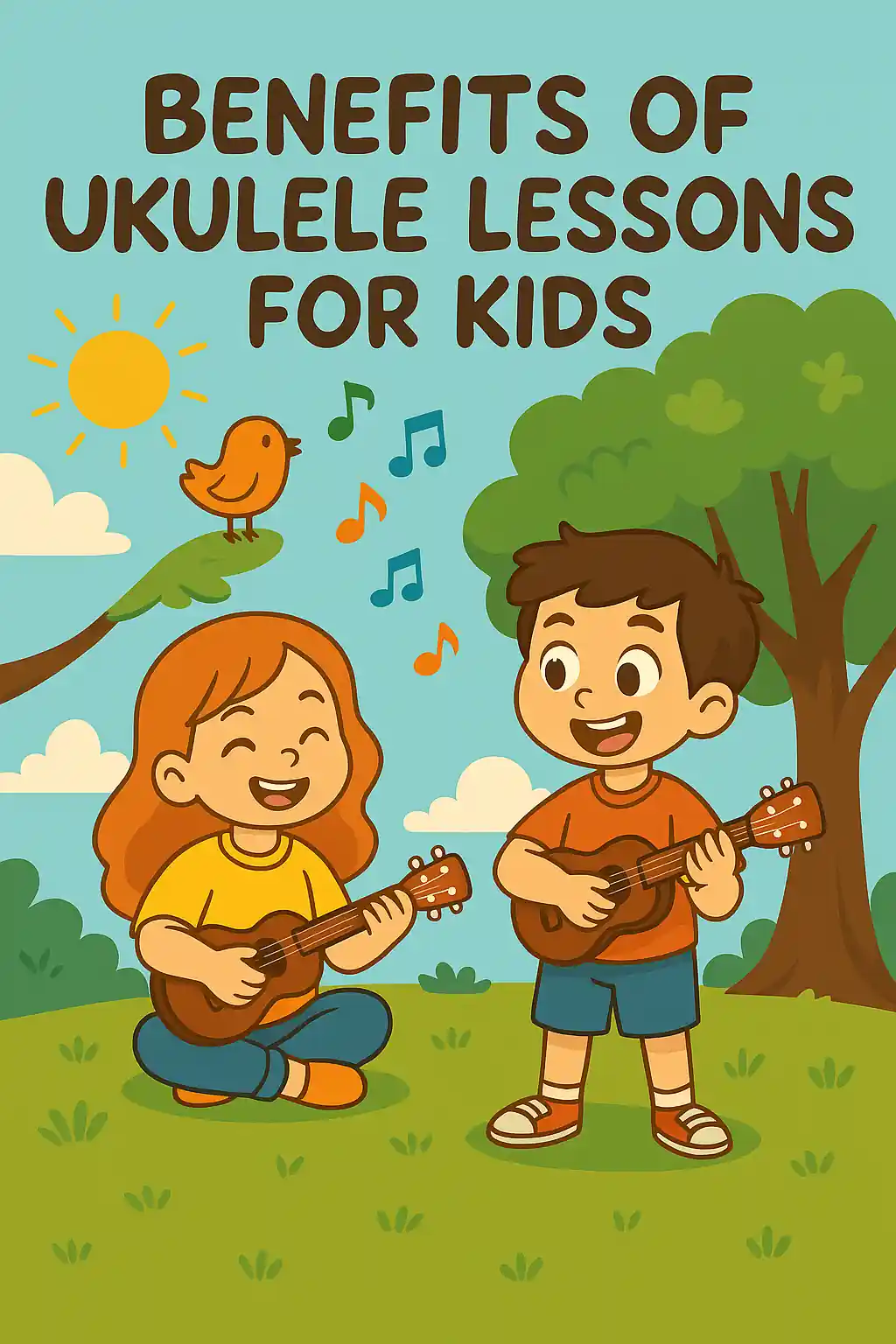
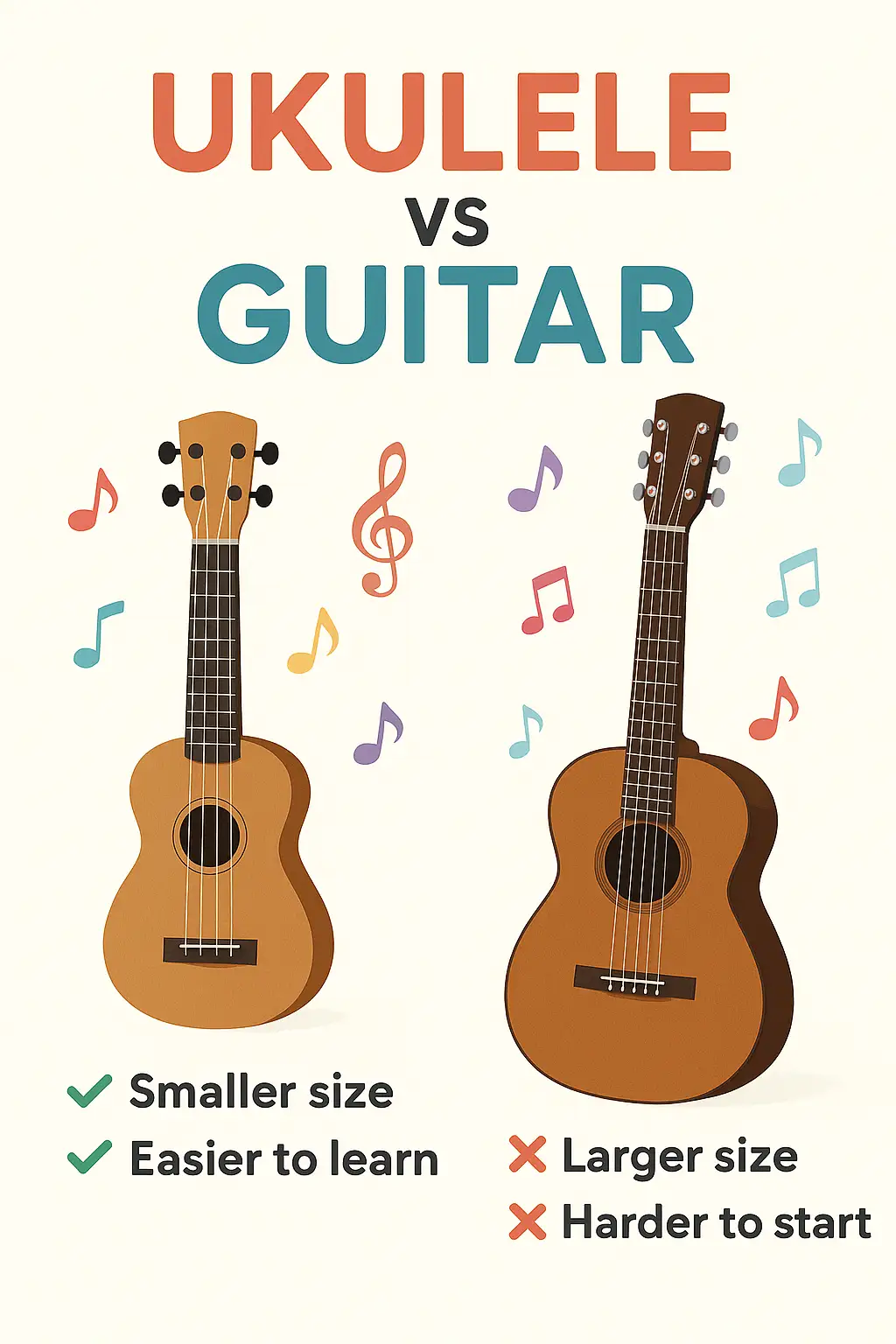
One of the most common questions parents ask is: “Should my child start with ukulele or guitar?” While both are great stringed instruments, they offer very different experiences for young learners. Let’s break down the pros and cons, so you can choose the best musical path for your child.
For many beginners, especially those under age 10, the ukulele is often the better choice. It’s smaller, lighter, and has only four soft nylon strings—making it easier to press and strum. These factors combine to make ukulele lessons for kids more comfortable and fun right from the start.
That said, as children grow older and develop stronger hands, many families consider transitioning to guitar. If you’re exploring this path, check out our online guitar lessons for kids, designed to build confidence and skills step by step.
Guitars, on the other hand, have six steel strings and larger fretboards. While they’re incredibly versatile and rewarding to learn, they can be more physically demanding for small hands. That’s why we recommend ukulele lessons for kids as the ideal first step, especially for younger or more sensitive learners.
|
Feature
|
Ukulele
|
Guitar
|
|---|---|---|
|
Size & Weight
|
Small & lightweight
|
Heavier & bulkier
|
|
String Count
|
4 strings (nylon)
|
6 strings (steel)
|
|
Ease of Learning
|
Easier for kids to start
|
Takes more effort to begin
|
|
Cost
|
Budget-friendly
|
More expensive
|
|
Best Age to Start
|
4 years and up
|
Usually 7 years and up
|
Still not sure? Here’s our recommendation: If your child is brand-new to music and under 10 years old, ukulele lessons for kids are a faster, more enjoyable introduction. The simplicity, comfort, and quick progress help kids stay motivated and proud of their success. Later on, transitioning to guitar will be much easier once they’ve built confidence and finger strength with the ukulele.
Our ukulele lessons for kids are crafted with young learners in mind—from the very first strum to the first full song. Every video is short, fun, and simple to follow. We use bright visuals, friendly teachers, and step-by-step guidance to keep kids engaged and motivated from day one.
Each lesson focuses on just one goal—like learning the C chord, strumming a rhythm, or transitioning between two chords. That way, kids don’t get overwhelmed, and they feel a sense of accomplishment every time they complete a step.
Short videos: Each lesson is under 10 minutes—perfect for short attention spans.
Step-by-step instructions: Kids learn one clear skill at a time.
Celebration of milestones: From first chord to full song, we cheer every success.
Parent tips included: Light guidance helps you support your child without pressure.
We know families are busy. That’s why our course is flexible. Lessons can be done on any schedule—after school, on the weekend, or whenever it fits. All you need is a ukulele, an internet connection, and a little curiosity!
It’s a true ukulele course for kids—not just random videos. Learners follow a clear path that builds skills and confidence step by step. Plus, they can replay any lesson as many times as they like.
Parents often tell us their child goes from “shy and unsure” to “singing and strumming proudly in the living room” within just a few weeks. That’s the magic of kid-centered music lessons: they spark joy, confidence, and creativity that spills into every part of life.
And best of all? No music reading is required. Our visual approach and fun pacing help your child start strong, stay motivated, and love learning music right from home.

You’ll be amazed what your child can do with short, joyful practice sessions. Our lessons are designed to make learning feel like play.
Within just a few weeks of starting ukulele lessons for kids, your child will already feel like a musician. Our approach makes progress visible and fun, turning practice time into playtime.
How to comfortably hold and tune the ukulele
First real chords: C, Am, and F
Basic strumming patterns with rhythm
Their first full song to play for family or friends
“Even kids with no music experience can play a recognizable tune within days. These small wins create huge motivation!”
Our ukulele lessons for kids are built on five core building blocks—each one designed to help kids feel confident, successful, and excited to keep going. Here’s what your child will learn in the first stage of their beginner ukulele course.
Kids learn a comfy, confident posture that makes playing easy and fun—seated or standing. A proper grip sets the foundation for smoother strumming and chord changes.
We teach the G-C-E-A tuning in a kid-friendly way, helping students hear and adjust their strings independently—an essential step for making music sound right from the start. For kids who want something a little more advanced, the guitar has six strings instead of four, offering a natural next step once ukulele basics feel comfortable.
Children start with four beginner chords—C, F, G, and Am. These simple shapes unlock dozens of fun, kid-friendly songs. By using just one or two fingers, kids quickly build strength and experience the joy of making “real” music from the very beginning.
Simple down strums and gentle down-up patterns help kids feel the beat, develop rhythm, and enjoy the flow of music. These patterns are introduced gradually, so children don’t feel overwhelmed. Parents often notice their child naturally tapping or clapping once rhythm becomes second nature.
Most students can play “Row, Row, Row Your Boat” or “Happy Birthday” within their first few lessons. This quick win sparks huge confidence and gives kids something exciting to share with family and friends. The sense of accomplishment makes them eager to keep practicing.
Kids learn a comfy, confident posture that makes playing easy and fun—seated or standing. A proper grip sets the foundation for smoother strumming and chord changes.
We teach the G-C-E-A tuning in a kid-friendly way, helping students hear and adjust their strings independently—an essential step for making music sound right from the start. For kids who want something a little more advanced, the guitar has six strings instead of four, offering a natural next step once ukulele basics feel comfortable.
Children start with four beginner chords—C, F, G, and Am. These simple shapes unlock dozens of fun, kid-friendly songs. By using just one or two fingers, kids quickly build strength and experience the joy of making “real” music from the very beginning.
Simple down strums and gentle down-up patterns help kids feel the beat, develop rhythm, and enjoy the flow of music. These patterns are introduced gradually, so children don’t feel overwhelmed. Parents often notice their child naturally tapping or clapping once rhythm becomes second nature.
Most students can play “Row, Row, Row Your Boat” or “Happy Birthday” within their first few lessons. This quick win sparks huge confidence and gives kids something exciting to share with family and friends. The sense of accomplishment makes them eager to keep practicing.

Give your child a joyful start in music! Our kid-friendly lessons make learning piano, guitar, and ukulele fun and engaging — plus singing, music theory, and creative activities like chess & drawing.
One of the biggest challenges for families is finding time to practice. That’s why our ukulele lessons for kids are designed around short, joyful sessions that fit easily into daily life. Just 10 minutes a day can build steady progress without frustration.
Instead of long, tiring routines, children work on a single goal—whether it’s strumming a rhythm, playing one new chord, or revisiting a favorite song. These bite-sized steps make practice feel more like play than work.
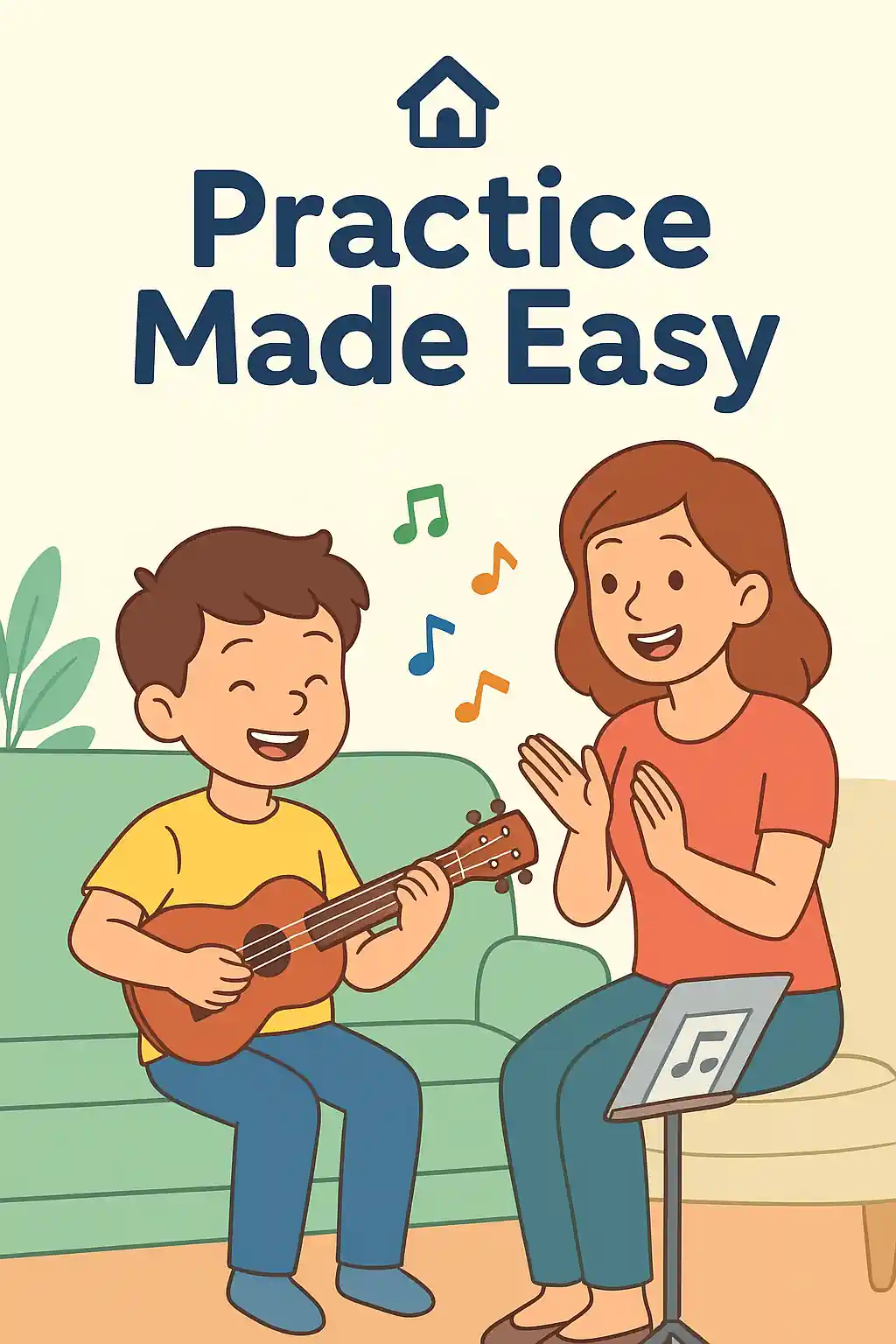
A regular time after school works best.
5–10 minutes is enough for young beginners.
Clap and cheer for small wins, not just perfect songs.
Leave the ukulele on a stand where kids can see it daily.
Parents tell us that once practice feels fun, kids start picking up the ukulele on their own—even outside lesson time. That’s the real secret: practice doesn’t have to feel forced when it’s made easy and enjoyable.
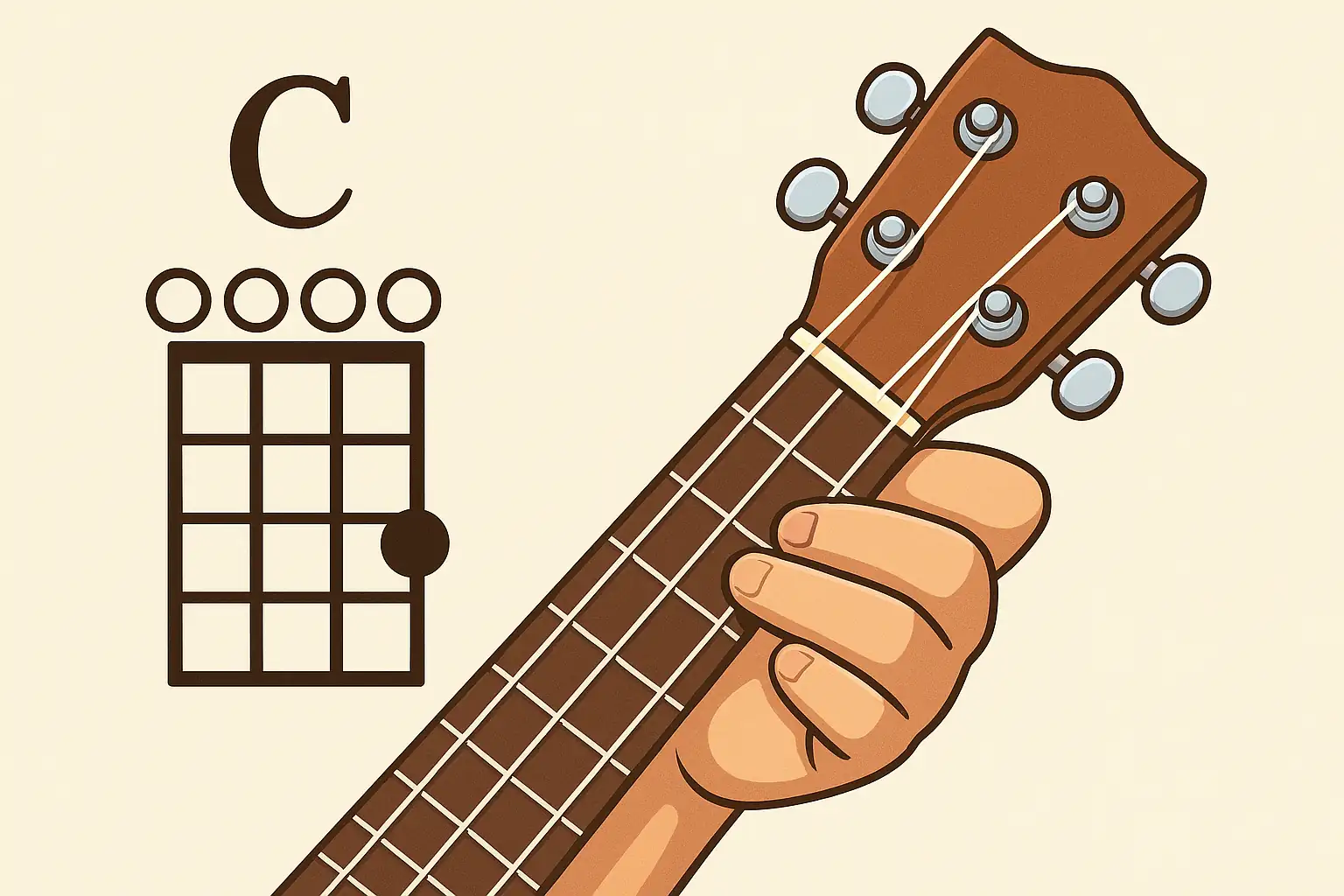
One of the most exciting milestones for any beginner is playing their first chords. Our ukulele lessons for kids focus on easy starter chords that sound great and build confidence quickly. Even with just two or three chords, your child will be able to play dozens of songs they already know.
The ukulele has a big advantage over other stringed instruments: its four soft nylon strings. They’re gentle on small hands and require less finger strength than a guitar. That means kids can press down on the frets without discomfort, making it easier to form chords and keep practicing happily.
Here are the starter chords we introduce step by step, each one chosen for its simplicity and usefulness:
C chord: Played with just one finger on the bottom string. This is often the very first chord kids master, because it’s simple and sounds great on its own.
Am chord: Another one-finger chord, giving kids early success while introducing them to a different sound.
F chord: A two-finger shape that feels natural once C and Am are comfortable. It also leads into many popular children’s songs.
G7 chord: Slightly more challenging, but rewarding—kids love how it makes their songs feel complete and “real.”
These first chords aren’t random—they unlock the ability to play familiar songs like “Row, Row, Row Your Boat”, “You Are My Sunshine”, and even “Happy Birthday”. With just C, Am, and F, kids can strum through a surprising number of tunes. Adding G7 expands their musical library even further.
Playing recognizable songs early gives children a huge motivational boost. Instead of endless drills, they get to show off real music to their family— which makes them proud and excited to keep learning.
As children rotate between these chords, they strengthen finger coordination, rhythm, and memory. Switching from C to F or Am to G7 may feel tricky at first, but every successful transition builds resilience and problem-solving skills. Parents often notice that their kids carry this same determination into schoolwork, sports, and other hobbies.
Another benefit is that these chords are used in countless pop and folk songs. That means as kids grow, they can keep using the same chord shapes to play more advanced music— making the ukulele an instrument that grows with them rather than something they outgrow.
Takeaway: By mastering just four easy chords—C, Am, F, and G7—kids can strum along with dozens of real songs. This makes practice fun, rewarding, and confidence-building from day one.
Parents often wonder which option will give their child the best start. Let’s compare the benefits of online ukulele lessons for kids with traditional in-person lessons.
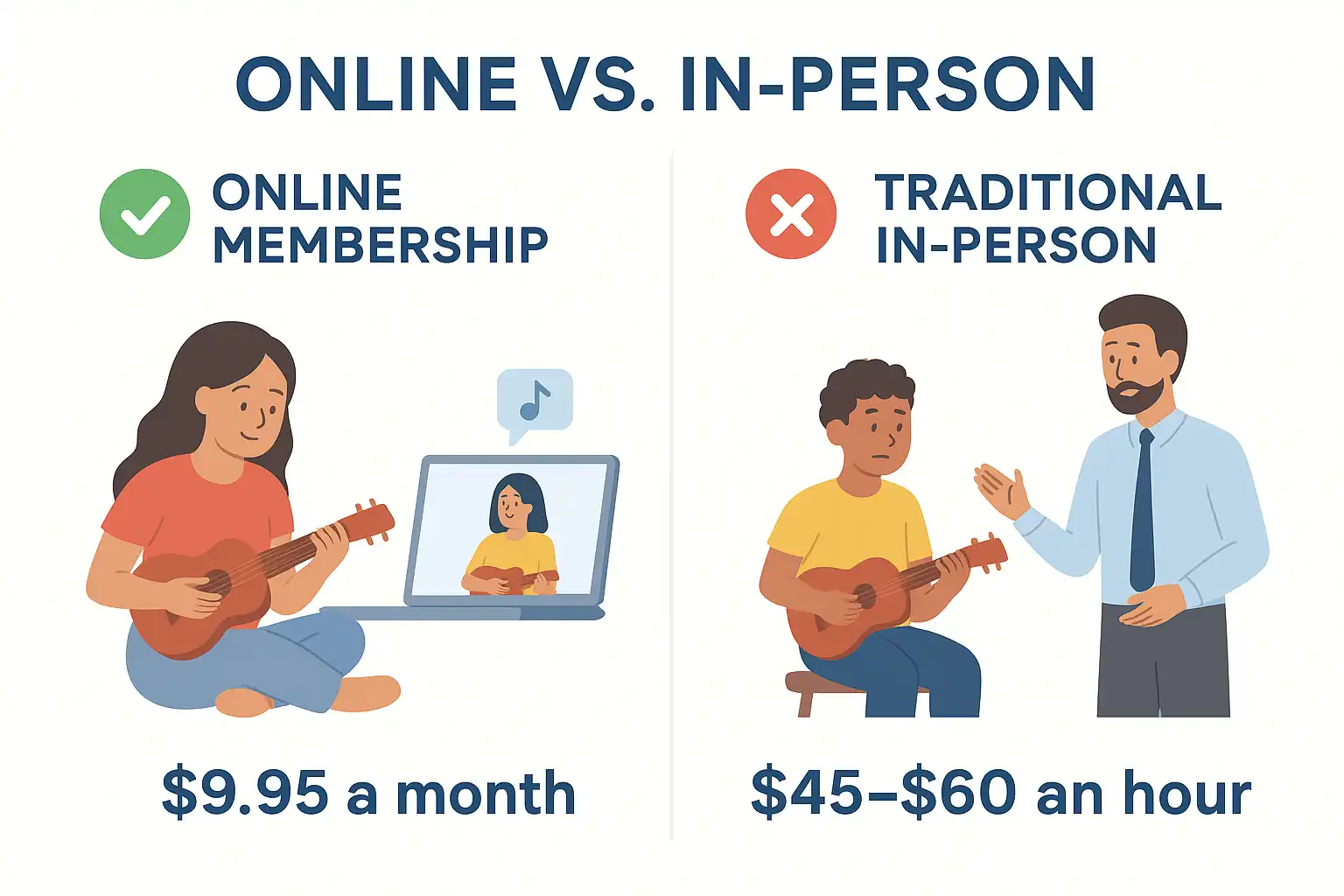
 Online Membership
Online Membership$9.95 /month
 Traditional In-Person
Traditional In-Person$45–$60 /hour
Takeaway: For under $10 a month, online ukulele lessons for kids give your child more flexibility, faster progress, and a fun, affordable way to learn. Compare that to $45–$60 for just one hour in person—where progress often crawls through basics.
When parents search for ukulele lessons for kids, they want proof that the lessons actually work. Nothing speaks louder than real reviews from families and students who are already enjoying the program. Below are some of the most common experiences our students and parents share.
i didn’t think i could play anything on a instrument before. then i watched the first video and it showed me the C chord. i pressed my finger down like the teacher said and strummed it and it actually sounded like real music! my mom came in the room and she smiled so big cuz she didn’t expect me to play so fast. i even showed my little sister and she laughed and clapped. i was suprised it only needed 1 finger and it wasn’t even hard. now i wanna learn the next chord and keep going cuz it makes me feel proud every time i play it.
I didn’t think my son would stick with music, but these online lessons surprised me. After just two weeks he played ‘Happy Birthday’ for his grandma and the whole family clapped. At only $9.95 a month, I couldn’t believe how much he learned compared to a $50 in-person class.
i learned the C and Am chords from the beginner video and i was shocked how easy it was. my mom smiled so much when i showed her. i feel proud cuz i can play real songs now.
As a parent, I appreciate how organized the curriculum is. My daughter not only learned chords quickly, but she also developed the habit of practicing 10 minutes a day because the videos make it simple and fun. The confidence boost she’s gotten from playing music has carried into other areas of her life, like school presentations and reading aloud in class.
We tried in-person lessons before and paid almost $60 for one hour where my child only learned how to hold the ukulele. With these online lessons, for the same price we got six months of music training that included ukulele, guitar, and piano bonus content. That’s real value for families.
These stories reflect what makes our program different: affordable pricing, kid-friendly teaching, and fast results. By combining step-by-step video lessons with a practice system kids enjoy, our members stick with music longer and feel proud of their progress. Whether your child wants to play their first song for family, build confidence at school, or explore other instruments, our reviews show that online ukulele lessons for kids are a proven path to success.
From music lessons to drawing and chess, JamGuitar makes learning fun and engaging for kids.
